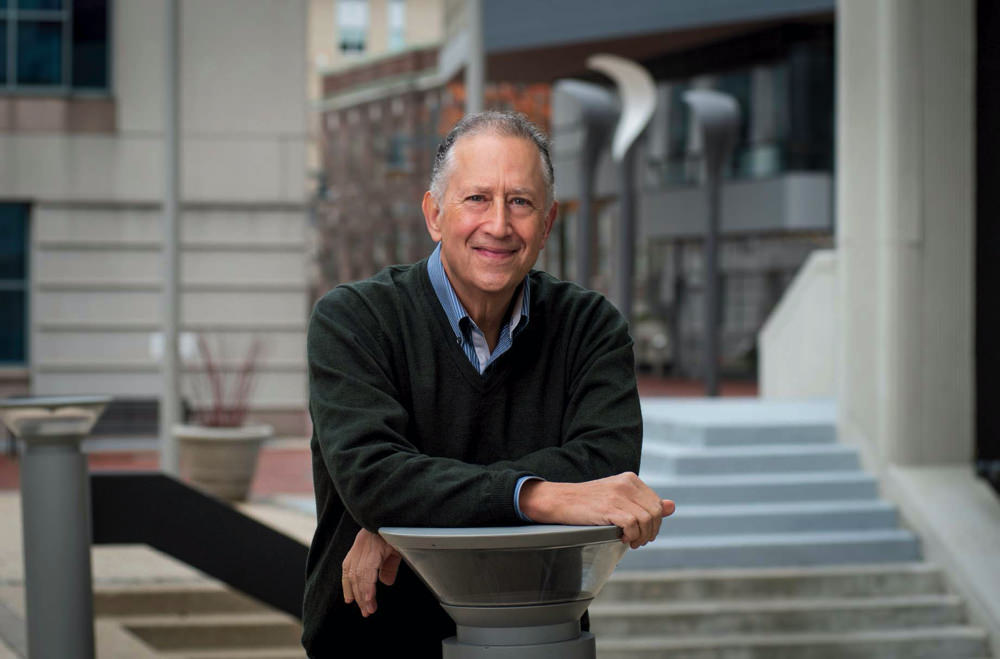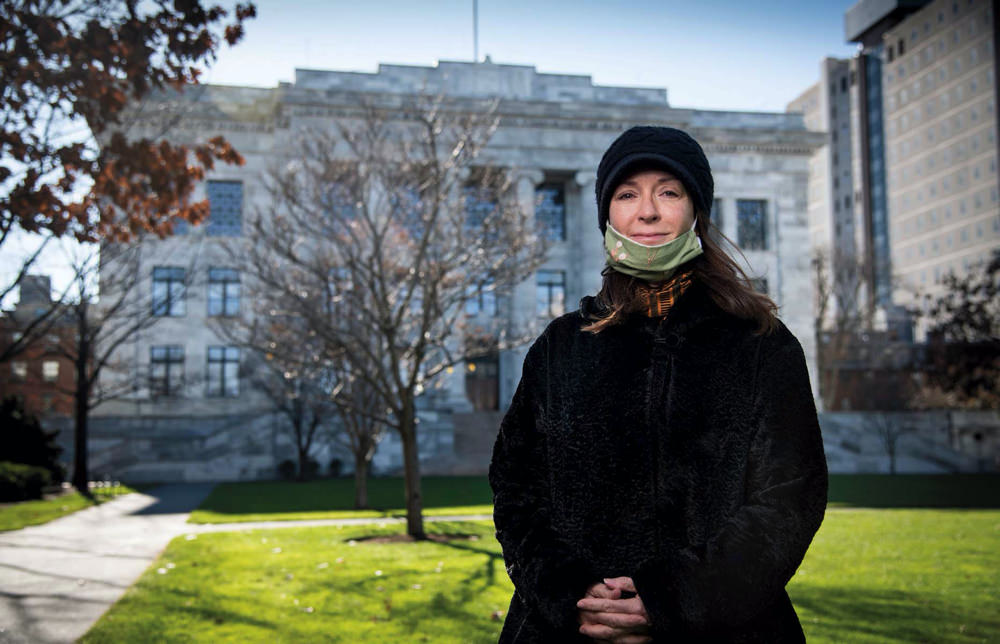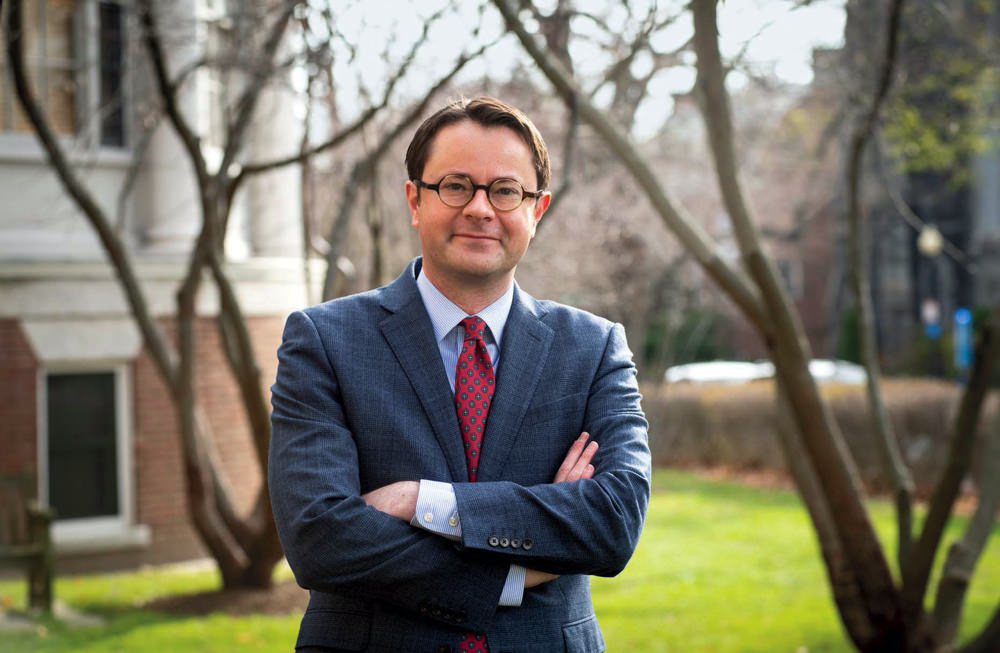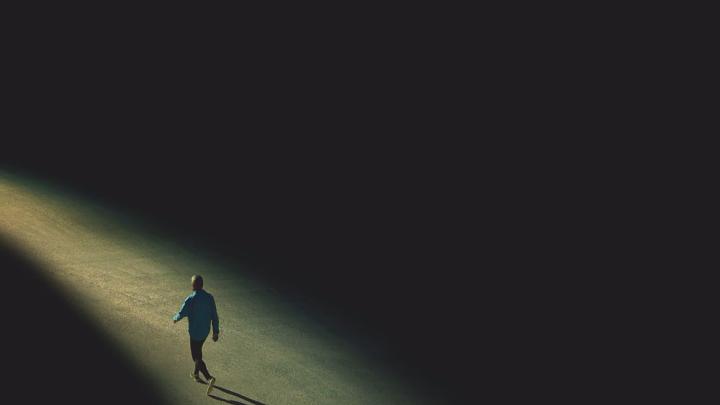Bradley Riew ’18 had a calendar reliably packed from 9 a.m. to midnight. To him, that didn’t seem so bad. “You know,” he says, “you have nine hours to sleep.”
On top of his schoolwork and various extracurriculars, he spent about 20 hours a week volunteering at local homeless shelters. He acknowledges now how well he fit the “overworked Harvard student” stereotype, but during sophomore year the commitments didn’t strike him as unusual. “I was just doing what everyone else was doing,” he says. “I was just absorbed in that culture of go, go, go, go, go.”
But the packed days strung together, the work piled on, and Riew felt more and more drained. Classwork encroached later into the night, and he went to bed with a level of exhaustion that rest couldn’t fix. “I didn’t really have time to do my schoolwork,” he recalls, “and I didn’t have time to just relax or spend time talking to somebody.”
Riew had no problem connecting with others, but keeping in touch and forming strong friendships was harder. He’d think about reaching out to someone, only to realize that they hadn’t spoken for months and decide the effort wasn’t worth it. Potential friends were now just friendly acquaintances. “And all my relationships were like that,” he says.
His productivity outpaced his social life, until it didn’t. His grades began to slip, and he started feeling depressed. “I got to the point where I didn’t care about anything I was doing,” he admits. “I was doing it because I had been doing it before.” He decided to take a leave of absence after that year, staying home in St. Louis. Only when the noise of undergraduate life began to fade did he finally begin to see the root of his problems: though he was far from alone, he was lonely.
Loneliness is a subjective experience—part of what makes it so hard to identify. “If you’re on Mars and you have the most powerful telescope, that can look through walls, you can find all the isolated people on planet Earth,” says Jeremy Nobel, a lecturer at the Harvard T.H. Chan School of Public Health (HSPH) who teaches a course on loneliness. “But you couldn’t find the lonely people.”
The opposite is true as well, says Robert Waldinger, professor of psychiatry and a psychiatrist at Massachusetts General Hospital (MGH). “You’ve probably known people who seem to have a lot of friends, but when they talk about it, they’ll say, ‘I don’t really feel like anybody knows me,’ or ‘I don’t really feel close to many people.’”
Social psychologists define loneliness as the gap between the social connections you would like to have and those you feel you experience. According to a 2018 report by the Henry J. Kaiser Family Foundation, 22 percent of adults in the United States say they often or always feel lonely or socially isolated. A national 2019 survey led by health insurer Cigna found that 61 percent of Americans report feeling lonely. Books like Bowling Alone (2000), by Malkin professor of public policy emeritus Robert D. Putnam, have highlighted the decline of social capital in the United States, but more recently, loneliness has become a serious issue of public health. In 2017, former U.S. Surgeon General Vivek Murthy ’97 called loneliness a public-health “epidemic.” The United Kingdom appointed a “minister for loneliness” a year later.
The health implications of loneliness have become clearer over time. According to the research of Julianne Holt-Lunstad, professor of psychology and neuroscience at Brigham Young University, and colleagues, the heightened risk of mortality from loneliness equals that of smoking 15 cigarettes a day or being an alcoholic, and exceeds the health risks associated with obesity. Researchers are now actively studying the mechanisms by which loneliness affects health, including its relationship with inflammation and harmful changes in DNA expression. “If you’re stressed chronically, your body may be in a low-level fight-or-flight response all the time,” Waldinger explains. “So what we are looking at is whether some people are in a chronic state of mild inflammation.”
COVID-19 has pushed loneliness further into the public conversation as people across the country have stayed home, fearful of contracting a deadly virus and aiding its spread. Terms like “social distancing,” “self-isolation,” and “shelter in place” accentuate the idea that COVID-19 could have profound social implications. “A major adverse consequence of the COVID-19 pandemic is likely to be increased social isolation and loneliness,” argued several professors in The Lancet Psychiatry in April. “Tracking loneliness and intervening early are important priorities.” “We’re all lonely now,” novelist Olivia Laing wrote in a New York Times column days after lockdowns began. “Social distancing is vital, but that doesn’t make it easy.”
Karestan Koenen, professor of psychiatric epidemiology at HSPH, always keeps an eye out for disasters. It’s part of her job; much of her work deals with trauma and post-traumatic stress disorder. But Koenen started thinking much more about COVID-19 when she began to see the virus’s potential implications for public health.
It began when one of her master’s students returned to the United States from Shanghai before the 2020 spring semester. As he quarantined—the first person she knew who had to do so—he described the situation he’d observed back in China. When they finally met in person, he began to sob uncontrollably.
“He just started crying and saying how awful he felt being in the U.S. when everyone was suffering in China,” Koenen recalls. “His colleagues were having PTSD, having dealt with SARS.” In Wuhan, he’d heard, doctors saw entire families dying, without full knowledge of what was going on. He’d also witnessed discrimination against people from Hubei province. He and Koenen started thinking through potential Chinese government public-health responses to the pandemic—and it struck her that the United States might have to prepare for similar trauma soon.
In March, a week before Harvard began sending students home, Koenen and some of her students and colleagues decided to meet to discuss various mental-health threats involving COVID-19. She added that everyone was free to invite those who might be interested. The group’s meetings usually drew only a handful of people, but when the Zoom call began—during the same afternoon when the World Health Organization declared the novel coronavirus a pandemic—more than 100 people were there. Instead of a group discussion, she and her colleagues presented what they knew about the mental-health repercussions of past pandemics. “A lot of people were thinking about this, and no one had any place to go,” Koenen says. “Clearly there was this huge need.”
Soon their group was hosting weekly forums, discussing the mental-health issue they felt most relevant. At first, the topics reflected the general concerns of past disasters: explaining the pandemic’s impacts on children, handling death and bereavement, and offering guidance on remaining resilient when the future is opaque. “We don’t know how long this thing will last,” she said in the first meeting. “This is a marathon, not a sprint….Really taking care of yourself and keeping routines is really important for kids, and adults too.”
Still Koenen remembers a frantic energy of connectedness. People were putting up signs for essential workers, organizing nightly Zoom dinners, spearheading Zoom book clubs. But as it became clear the pandemic wasn’t going away soon, people had to adjust and move forward in a far different way than they’d imagined. “I don’t think the immediate impact of COVID was people being lonely,” Jeremy Nobel says. “I think what it did do is raise the consciousness of people around isolation…. So I think as people started anticipating future reductions in social contact, it increased anxiety and also, as people started removing themselves from others, it increased the risk for loneliness.”
Loneliness is not monolithic. When most people think of the feeling, they think of what Nobel calls psychological or interpersonal loneliness. “Like, ‘Do I have a friend? Do I have someone I can tell my troubles to?’” he says. But there’s also existential loneliness: “Do I fit into the universe? Does my life have any meaning, purpose, weight, valence, mission?” He finds such questions particularly troublesome for 18- to 24-year-olds, who are, studies have shown, the loneliest group in the country. The third type of loneliness is societal: “If I enter a room, is my arrival both anticipated and welcomed?” Prejudice can augment this type of loneliness, Nobel says, most notably through racism. “But it goes beyond race, class, and gender preference,” he adds. “It affects anyone subject to exclusion, including people who don’t meet our beauty standards, people with disabilities, even many older adults….Society systematically excludes people, often.”

As president of the Foundation for Art & Healing, Jeremy Nobel launched “The UnLonely Project” to increase public awareness of loneliness and lessen its burden.
Photograph by Brian Smith
Loneliness was rising even before the pandemic. “Modern progress has brought unprecedented advances that make it easier for us technically to connect,” writes Vivek Murthy in Together: The Healing Power of Human Connection in a Sometimes Lonely World, “but often these advances create unforeseen challenges that make us feel more alone and disconnected.” Social media, for instance, can bring people together with mutual interests or make it easier for friends to make plans, but it also amplifies disagreement and siphons people into increasingly divisive echo chambers. “Because of these divisions, many people are just hunkering down, I think,” Robert Waldinger says. And, he adds, they’re not necessarily happy, huddling in their tribes. “Many people are disturbed by all this, so you see levels of depression and anxiety going up in the population.”
“If you’re lonely, almost the last thing you want to do is reach out,” Karestan Koenen says. “But you have to make yourself.”
And loneliness begets loneliness. “If you’re lonely, almost the last thing you want to do is reach out,” Koenen says. “But you have to make yourself.” She saw the risks for her mother, who has a history of depression and lives alone in Atlanta. Koenen wanted to visit, but it never seemed wise as the pandemic raged in Massachusetts and then took hold in Georgia. To keep her mother engaged socially and focusing on topics other than politics, Koenen and her brother decided to call her each day and have her tell them what she was doing to get out of her apartment or connect with someone else online or by phone. “We’re often better when we’re accountable to other people,” she says. “That’s why you do it in therapy. If you can have someone call you and ask, ‘What did you do today?’ it might be a little motivating.” Her mother might go out just to have something to tell the kids, but that could make her feel better nonetheless.
Meanwhile, Koenen felt her own communication with others had become strained. “We’re in this together, but feeling so alone,” she says. “Although we have these shared experiences, because we’re deprived of so many [other] ways we would connect with people around us, it feels isolating.” She woke up one Saturday to a text from her sister saying that her father-in-law had passed away. A few days later, his wife did, too. “In life pre-COVID, I would be in Saratoga, helping with and taking comfort in the logistics and rituals of death,” she wrote in May. “As an older sister, professor…and clinical psychologist at the Massachusetts General Hospital, I am usually the person in the family everyone relies on to know what to do in a crisis. But instead, I remain in Boston, physically distant and emotionally helpless.”
The gradual reopening of society didn’t always make social connection easier. At times, new decisions about how to interact with others created tension among friends and family. “The people who are alone alone are really lonely,” Koenen says, “but people are feeling isolated even with the people they live with, because there’s a lot of stress and conflict.” Some couples have struggled over how strictly they should avoid other people and families—arguing about whether it’s appropriate to go to an outdoor restaurant or invite friends onto a front patio. Such discrepancies in comfort level have also occurred among families in the same neighborhood. While some children bike outside in groups or play soccer wearing masks, others aren’t allowed to get within 20 feet of their friends, even outdoors.
“What the pandemic did was it froze our lives, right?” Waldinger says. “It froze us in these weird positions where we’re closer than we want to be to some people, and we’re too distanced from others.” He mentions the evaporation of “weak ties” as another possible contributor to feelings of loneliness: “your relationship with the guy you always get your coffee from at Starbucks, or the mail carrier, or the person who checks you out at the grocery store, who you chat with”—or relationships with co-workers or acquaintances. A body of research suggests that these ties are meaningful and predominantly positive. Waldinger himself normally went to MGH every day for work, but by fall, he hadn’t been there in months. Seeing colleagues via Zoom is not the same, he says—and there are people he frequently interacted with in the coffee room whom he would never see in a Zoom call.

To improve mental health in times of stress, Karestan Koenen recommends “the boring stuff”: going to bed and waking up at consistent times, exercising, and scheduling enjoyable activities.
Photograph by Brian Smith
And when people feel bad themselves, building relationships with others becomes more difficult. Although Koenen noticed people being quite proactive in connecting or reconnecting with friends when lockdowns began, she thinks some have increasingly decided to deal with their own issues privately. She sees friends on Zoom and says, “Why didn’t you ever tell me that?” and they say, “Well, I know things suck for you, so why would I?”
When the pandemic took hold in the United States, Jeremy Nobel and his staff began to act. He had established The Foundation for Art & Healing in 2004, an independent nonprofit to help people heal emotionally through art-focused activities. Faced with this new threat, the organization launched the “Stuck at Home Together Initiative.” On their website, they encouraged anyone interested to participate in a variety of creative activities—and share the results with others in the group. The idea was spurred by Nobel’s research into how creative processes can enhance well-being and help alleviate loneliness. “It was just a way to bridge the gap,” he says, “offering a chance to be socially connected authentically, even at a time of distancing.” Some people joined virtual creative social circles; others “attended” the UnLonely Film Festival, an online screening of short films about loneliness and isolation, and discussed each film in groups.
Those reactions helped Nobel notice something. “People are typically embarrassed or ashamed about loneliness because they think it ties to some kind of inadequacy or deficiency on their part,” he says. But COVID-19 presents obvious reasons for people to feel lonely—involuntary isolation, quarantining—“So what’s different about this loneliness is it actually has the potential to be unifying.”
This potential for increased connection was observed in research, too. In June, Tyler Vanderweele, professor of epidemiology and director of Harvard’s Human Flourishing Program, found some information that surprised him. An unrelated collaboration with the American Bible Society had caused his group to collect well-being data from thousands of participants in January and then in June. The results offered some unexpected COVID-19 insight, he says: he’d expected participants to experience major declines in their “close social relationships,” but in fact, those statistics declined only modestly.The research had evaluated well-being across six domains: happiness and life satisfaction, mental and physical health, meaning and purpose, character and virtue, close social relationships, and financial and material stability. Vanderweele observed that well-being overall was down, notably, with the largest decline in “financial and material stability.” But scores for “meaning and purpose,” “character and virtue,” and “close social relationships” declined much less significantly—each about a tenth of a standard deviation (Correction 12/23: "a tenth" originally written as "a third.") “I think people are reevaluating their lives,” he says, “and trying to find meaning in the midst of what is a very difficult set of circumstances.”
Though opportunities to meet new people and attend events have diminished, Vanderweele suspects that many people—especially those who report their close social relationships improving during this time—have put extra energy into connections they had pre-pandemic. “I tend to think what this time has required for either successful social engagement or successful community engagement is really drawing upon the resources of the past,” he explains. “What relationships do you already have in place? And can you make use of them and invest in them?” In addition to strengthening relationships with family members and close friends, he believes some people are taking the opportunity to revisit past friendships that were lost over an argument or a dispute: salvaging past connections even when forming new ones is difficult.

Tyler Vanderweele hopes the pandemic may spark “renewed interest not just in reestablishing social relationships, but also in participating in deeper, richer forms of community life.”
Photograph by Brian Smith
Vanderweele sees some of these trends in his own life. Though he feels the loss of interactions with work colleagues and members of his church community acutely, he has gone from seeing his extended family every couple of months to chatting with them every week on Zoom. “That really has enriched those relationships,” he says.
But while overall declines in social relationships are modest, variance among these self-reports has increased. Some saw their relationships improve, but others saw a sharp decline. Vanderweele thinks that those living alone or lacking much community support fared especially poorly during widespread societal restrictions.
When people ask Robert Waldinger how to improve social relationships, he emphasizes the need to be active. “It’s being the one to reach out,” he says, even when that’s hard to do. “If you’re feeling worse about yourself or about your life, it can be hard to say, ‘I’m going to call up that friend I haven’t seen in a while.’”
“The virus doesn’t know tribes, it doesn’t know boundaries, it just doesn’t know,” says Robert Waldinger. “And that, in some ways, is a dramatic reminder of how connected we are.”
“Mostly, we think our relationships just are what they are, and they take care of themselves,” he adds. The pandemic has played a part in disabusing people of that notion, forcing people to think harder about the social interactions they are and aren’t having, and how they can maintain them. “The one thing that the pandemic does is it really emphasizes our interconnectedness, right?” he says. “The virus doesn’t know tribes, it doesn’t know boundaries, it just doesn’t know….And that, in some ways, is a dramatic reminder of how connected we are.”
“I think the stigma of loneliness can change radically right now,” Nobel says. “We’re lonely now not because someone might not like us, or we might get rejected….We’re lonely because we’re forced to take very specific actions in response to a common enemy.” And when the reasons for loneliness are clear, the answers may come more easily, too.
It took some time for Bradley Riew to realize that his problem, above all else, had been loneliness. But that awareness, and knowing that it wasn’t his fault, enabled him to do something about it.
When he returned for his junior year in 2016, he reduced his volunteering from 20 hours to four hours a week. He hung out with his roommates a lot and sought out students who valued “being there for friends” as much as he did—something that wasn’t always easy in the fast-paced Harvard environment. Slowly, he felt his network growing; he felt less alone and saw there were people around whom he trusted and who trusted him. “I realized that it doesn’t really matter how much work I do and how much stuff I put out,” he says. “What really matters is who do I hang out with on Friday? And do I show up for them when they need me to be there?”
Seeing how investing in connections improved his life, he began working with Jeremy Nobel at the Foundation for Art & Healing. He focused much of his work on the organization’s “UnLonely Project,” where he helped spread awareness about loneliness and how to cope. When lockdowns began, he helped transition the “Aging UnLonely” support group, for adults over 65, to a Zoom environment.
The social implications of COVID-19 might have thrown Riew for a loop years ago, but now they strike him more as a personal challenge—“Like, ‘Okay, well, we’re going to level up and throw you something harder.’”
It’s still tough. He lives in New York City, now working at the mental-health nonprofit BrainFutures, but his friends are all across the country. His co-workers are friendly, but not really his friends, and he no longer sees them in person. But he doesn’t feel any reason to suffer quietly with loneliness. He might not always have the energy to reach out, but he knows doing so will keep him grounded and sane, even if it means going for long walks in Central Park with friends while keeping six feet apart and wearing masks.
“I think there’s a lot of people out there who are suffering quietly and don’t really know why. For a subset of those people—the reason why is loneliness. That’s the thing,” he says. “It’s like turning the light on. Once you see it, then you know, and then you can act.”







